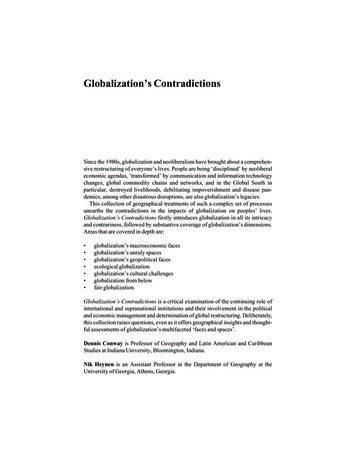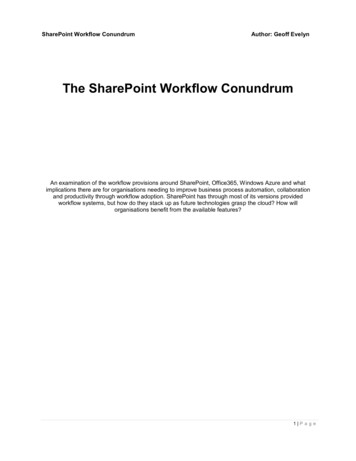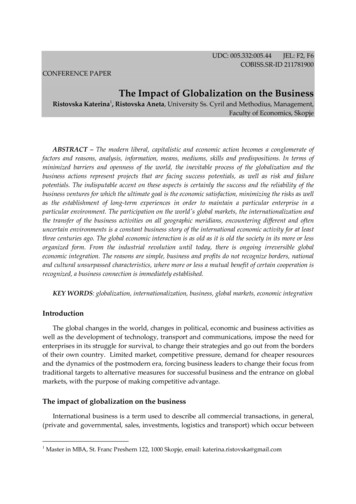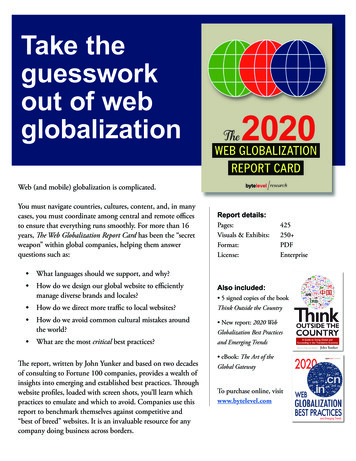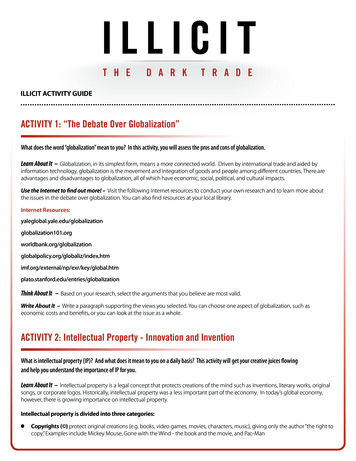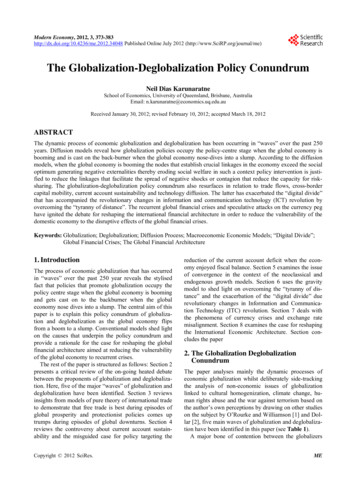
Transcription
Modern Economy, 2012, 3, 373-383http://dx.doi.org/10.4236/me.2012.34048 Published Online July 2012 (http://www.SciRP.org/journal/me)The Globalization-Deglobalization Policy ConundrumNeil Dias KarunaratneSchool of Economics, University of Queensland, Brisbane, AustraliaEmail: n.karunaratne@economics.uq.edu.auReceived January 30, 2012; revised February 10, 2012; accepted March 18, 2012ABSTRACTThe dynamic process of economic globalization and deglobalization has been occurring in “waves” over the past 250years. Diffusion models reveal how globalization policies occupy the policy-centre stage when the global economy isbooming and is cast on the back-burner when the global economy nose-dives into a slump. According to the diffusionmodels, when the global economy is booming the nodes that establish crucial linkages in the economy exceed the socialoptimum generating negative externalities thereby eroding social welfare in such a context policy intervention is justified to reduce the linkages that facilitate the spread of negative shocks or contagion that reduce the capacity for risksharing. The globalization-deglobalization policy conundrum also resurfaces in relation to trade flows, cross-bordercapital mobility, current account sustainability and technology diffusion. The latter has exacerbated the “digital divide”that has accompanied the revolutionary changes in information and communication technology (ICT) revolution byovercoming the “tyranny of distance”. The recurrent global financial crises and speculative attacks on the currency peghave ignited the debate for reshaping the international financial architecture in order to reduce the vulnerability of thedomestic economy to the disruptive effects of the global financial crises.Keywords: Globalization; Deglobalization; Diffusion Process; Macroeconomic Economic Models; “Digital Divide”;Global Financial Crises; The Global Financial Architecture1. IntroductionThe process of economic globalization that has occurredin “waves” over the past 250 year reveals the stylisedfact that policies that promote globalization occupy thepolicy centre stage when the global economy is boomingand gets cast on to the backburner when the globaleconomy nose dives into a slump. The central aim of thispaper is to explain this policy conundrum of globalization and deglobalization as the global economy flipsfrom a boom to a slump. Conventional models shed lighton the causes that underpin the policy conundrum andprovide a rationale for the case for reshaping the globalfinancial architecture aimed at reducing the vulnerabilityof the global economy to recurrent crises.The rest of the paper is structured as follows: Section 2presents a critical review of the on-going heated debatebetween the proponents of globalization and deglobalization. Here, five of the major “waves” of globalization anddeglobalization have been identified. Section 3 reviewsinsights from models of pure theory of international tradeto demonstrate that free trade is best during episodes ofglobal prosperity and protectionist policies comes uptrumps during episodes of global downturns. Section 4reviews the controversy about current account sustainability and the misguided case for policy targeting theCopyright 2012 SciRes.reduction of the current account deficit when the economy enjoyed fiscal balance. Section 5 examines the issueof convergence in the context of the neoclassical andendogenous growth models. Section 6 uses the gravitymodel to shed light on overcoming the “tyranny of distance” and the exacerbation of the “digital divide” duerevolutionary changes in Information and Communication Technology (ITC) revolution. Section 7 deals withthe phenomena of currency crises and exchange ratemisalignment. Section 8 examines the case for reshapingthe International Economic Architecture. Section concludes the paper2. The Globalization DeglobalizationConundrumThe paper analyses mainly the dynamic processes ofeconomic globalization whilst deliberately side-trackingthe analysis of non-economic issues of globalizationlinked to cultural homogenization, climate change, human rights abuse and the war against terrorism based onthe author’s own perceptions by drawing on other studieson the subject by O’Rourke and Williamson [1] and Dollar [2], five main waves of globalization and deglobalization have been identified in this paper (see Table 1).A major bone of contention between the globalizersME
N. D. KARUNARATNE374Table 1. Waves of globalization & deglobalization.Wave typeDurationPropellerEconomyArchitecture (IFA)Globalization I1870-1914ColonizationBoomGold StandardDeglobalization on II1939-1946Inter-WarSlumpInter-WarGlobalization II1946-1973Free TradeBoomBretton WoodsGlobalization III1980-2009Capital mobilitySlumpGeneralized FloatSources: O’Rourke et al. [1] and Dollar [2].and deglobalizers relate to the issue of reduction of poverty and income inequality. The deglobalizers have alleged that despite waves of globalization more than 1billion people live below the poverty line of less than 1US per day. In this morass of poverty more than 30,000children were perishing daily due to malnutrition andover 72 million children of whom 57% were girls had noprimary education and entered the new millennium asilliterates. The above poverty facts and stats constitute astrong indictment of past globalization as it has failed towork to improve the welfare of the poor in developingcountries as observed by Shah [3] (Table 2).Nonetheless, a more incisive analysis of the povertyand income inequality data based on the percentage ofpopulation living below the poverty line of US 1 perday over two decades 1960-1980 analysed according tothe major regions of the global economy reveal that thepercentage of population living below the poverty linehas fallen significantly in the emerging market economies of East Asia, South Asia and the oil producing nations of the Middle East while only Sub-Saharan Africahas been bypassed by the globalization process andshowed no significant reduction in poverty. Overall, thepercentage of persons living below the poverty line hasfallen by nearly 10% and for the first time the growingtrend of income inequality has reversed mainly due torapid growth and poverty alleviation programs that haveimplemented by the mega Asian economies of China andIndia as shown by Salvatore [4] (Table 3).During this last wave or Wave III of globalization, theeconomic centre of gravity that was located in the US-NorthEurope region started to shift to the East Asia-Pacificregion ushering in new era of globalization centred onthe emergent economies of East Asia and the Pacific.World development indicators revealed that in theEast-Asia Pacific region per capita GDP growth had increased at a whopping rate of nearly 9% per year, productivity had more than trebled, carbon dioxide emissions nearly doubled indicating that region was turninginto the leading engine of global economic growth whilstat the same time improving the quality of life as shownby reduction of infant mortality by nearly half , increasCopyright 2012 SciRes.ing life-expectancy from 67 to 71 years and increasingthe ratio of enrolment in tertiary education to more than20% (Table 4).In this paper, we use the modelling of diffusion process to explain the working of the paradox high startedwith the adverse shock of the US subprime mortgagemeltdown, which spread apidly erupting as a full-blownfinancial crisis. This ended the longest wave of prosperity, Wave III of Globalization, also known as the “GreatModeration” and engulfed the global economy in a fullblown financial crisis in August 2007 and commencedWave III of deglobalization policies during the worstslump that occurred since the Great Depression of the1930s. The US subprime mortgage meltdown, which hadits origin in the US housing market, had spread rapidlyworldwide and posed a systemic threat of a collapse ofthe global financial architecture or system. Based on insights from diffusion models during a global lump heinterconnection between crucial nodes exceed what isdesired from the social optimum requiring disconnectingnodes or deglobalization in order to regain economicstability. The adverse shock of the US subprime mortgage meltdown is transmitted around the network in twoways. First, the original shock may be sub-divided amongthe nodes resulting in risk-sharing. The analysis of theUS subprime mortgage meltdown reveals that the rootcause of the current global financial crisis can be tracedto the financial innovation of securitization which repackaged prime and subprime mortgages and increasethe marketability of these repackaged assets by creatingmortgage backed securities (MBS). The shift from “originate and hold” model to the “originate and distribute”model increased the marketability of securitized assetsbut at the same time by increasing counterparty risk created: a “credit crunch” and a “liquidity crisis” which rendered Wall Street institutions insolvent. However, theWall Street financial institutions were deemed to be either “too big to fail” or “too interconnected to fail” thatjustified a tax-payer funded bailout creating a seriousmoral hazard problems. The recurrent global financialcrises has led to calls to reshaping the international financial architecture (IFA).ME
N. D. KARUNARATNE375Table 2. Poverty facts and stats.Indicator of Developing Country Poverty1.50% of the world population (3 billion) live on less than 2 dollars a day.2.80% of the world’ population live in countries widening income inequality.3.20% of the world’s rich enjoy 75% of the global wealth while 40% of the world’s poorest account only 5% of the world’s wealth.4.30,000 children die every day due to poverty (UNICEF).5.28% of children in DCs are underweight or stunted.6.72 million children of primary school age do not attend school, 57% are girls.7.Over 1 billion people entered the new millennium illiterate.Source: Shah [3].Table 3. Number & percentage living below the poverty line (1960-2000) during Globalization Wave II & III.Region1960 (%)19802000East Asia729 (77.5)955 (67.2)114 (6.0)South Asia209 (37.2)310 (34.4)105 (7.8)Sub-Saharan Africa118 (53.2)188 (49.4)362 (54.8)Mid-East & N. Africa32 (24.3)10 (4.3)29 (7.2)Latin America35 (16.0)13 (3.6)27 (5.2)Eastern Europe29 (9.2)7 (1.7)0 (0)Developing World1131 (52.5)1479 (43.5)647 (13.1)Source: Salvatore [4]. Notes: (Poverty line: Living on less than US 1.00 per day measured in 1985 PPP Living on less than US 1.50 per day measured in1993 PPP).Table 4. World development indicators (1990-2006).Region% ΔPCGDP% ΔPROD% ΔCO2Infant MortalityLife Exp.Tertiary ed. Enrol. RatioEast-Asia Pacific8.631519856 to 2967 to 7120Sub-Sahara Africa3.01212123 to 8350 to 505High Income2.213512212 to 776 to 7967World2.614112892 to 7365 to 6824Source: Klein [7].3. Models of Pure Theory of Trade &ProtectionismA major force of driving economic globalization is tradeliberalisation or the removal of tariff and non-tariff barriers on the trade in goods and services. Pure theory ofinternational trade as exposited in the Riparian model,see Appleyard et al. [5] demonstrates that specialisationin the production of goods based on the principle ofcomparative advantage maximizes national and globalwelfare or is first best. However, when factor endowments are taken into account the Heckscher-Ohilin modeldemonstrates that free trade results in income distributionCopyright 2012 SciRes.effects or winners and losers. If the winners from tradecan potentially compensate losers and still be better offthe free trade is still first best. Although the rhetoric offree trade is strongly supported in multilateral trade negotiations as discussed by Pattnaik [6], under the auspices of the World Trade Organisation by the championsof free trade in reality these very champions cave intodemands of special interest groups and perpetuate, forexample, farm subsidies undermining both national andglobal welfare. The stalling of the 9th round of MTN orthe Doha round bears testimony to the fact that the political economy of protection overrides the benefits offree trade particularly, during periods of global economicME
376N. D. KARUNARATNEslow-down. The benefits of free trade clearly demonstrate that the Asian miracle has delivered high growthrates to a group of High Performance Asian Economies(HPAEs) that implemented export oriented industrialstrategies in contrast to several developing countries thatpursued inward looking import substituting industrialization (ISI) strategies. Besides, new trade theories that takeinto account the effects of economies of scale and monopolistic competition show that trade in similar but differentiated products between countries or intraindustrytrade as opposed to inter-industry or Heckscher-Ohlintrade in dissimilar products do not take into account perverse income distributional effects.The world’s centre of economic gravity has shiftedfrom the North America and Pacific region. Data onoverall economic activity, national accounts, demographics, sexual specifics, health life expectancy, energy, andoutput show that growth centres have shifted from NorthAmerica and Europe to Asia and America according toKlein [7]. Empirical studies show that this reduction ledto the reduction of the tyranny distance for countries likeAustralia. The reduction of the distance from the NorthAmerica-Europe to the Asian Pacific region has increasedthe potential for trade with the fast growing emergingmarket economies in China and India.The last wave or Wave III, of economic globalizationdubbed the “Great Moderation” delivered unprecedentedprosperity due to the financial innovations nurtured bythe spread of free market capitalism. However, unregulated free market capitalism also sowed its own seeds ofdestruction and resulted in the Wave III of economicglobalization that imploded in the US subprime mortgagemeltdown, which exploded as a full-blown global financial crisis in August 2007 engulfing the world in theworst global recession since the Great Depression of the1930s.The insights garnered from the diffusion models revealthat when the global economy is booming the interdependencies of the real and financial assets increase enhancing social welfare. However, when the global economy plunges into a slump the private incentives exceedthe social welfare optimum eroding the capacity of financial networks to reduce risk-sharing due to the crisiscontagion that arises from the increase in volatility.Risk-sharing is defined as the subdivision of the originalshock amongst the nodes of a network and crisis contagion is defined as the spread (multiplication) of the shockamong nodes of network (convergence). Diffusion processes suggest that during a global slump policy intervention should aim at disconnecting the economy at crucialnodes to reduce private incentives that exceed the socialoptimum. Besides, policy intervention should be directedat revamping institutions and not rescuing bad managersincreased inefficiency by causing the divergence of priCopyright 2012 SciRes.vate from the social welfare optimum.The subprime mortgage meltdown which unravelled asthe worst global recession in August 2007 since the GreatDepression of the 1930 ended the Great Moderation or along-boom in the global economy plunging the globaleconomy in a slump. As predicted by the diffusion processes model the global slump increase the interdependencies between the financial and real sectors. The subprime mortgage meltdown affected securitization or thepooling of prime and subprime mortgages and obtainingfor these asset backed securities high rating from hedgefunds thereby increasing their marketability world-wide.The process of pooling subprime mortgages with primemortgages which radically changed banking lendingfrom the “Originator to Hold” model to “Originator toDistribute” model enabling banks to obtain high ratingsfrom hedge funds for the asset backed securities and increase their marketability world-wide. During economicbooms when house prices were rising subprime mortgagees were able to refinance their loans and meet theirrepayments. However, the US housing price bubble burstand housing prices plummeted the subprime mortgageeswere unable to meet the high interest payments and therefore they sold their houses increasing the supply house ata time when demand was low. This caused a further fallin house prices and forced subprime mortgagees to default on their repayments and banks to foreclose on them.The negative feedbacks arising from the US subprimemortgage meltdown was transmitted globally becausemany foreign banks, hedge funds, superannuation fundsand other investors had bought asset backed securitieswhich had mispriced risks in their search for higheryields.The US subprime mortgage meltdown created a “creditcrunch” which spawned a “liquidity crisis” and lendingagencies were unable to obtain loans from the interbankmarket to meet the demand for credit for maturities ofmore than month because of the widening gap in interbank spreads due to increase in counterparty risk. Thisdrove Wall Street financial institutions to the throes ofbankruptcy and insolvency. However these Wall Streetfinancial institutions were deemed to be “too big to fail”or “too interconnected to fail”.The insights garnered from the diffusion models revealthat when the global economy is booming the interdependencies of the real and financial assets increase enhancing social welfare. However, when the global economyplunges into a slump the private incentives exceed thesocial welfare optimum eroding the capacity of financialnetworks to reduce risk-sharing due to the crisis contagion that arises from the increase in volatility. Risk-sharingis defined as the subdivision of the original shock amongstthe nodes of a network and crisis contagion is defined asthe spread (multiplication) of the shock among nodes ofME
N. D. KARUNARATNEnetwork (convergence). Diffusion processes suggest thatduring a global slump policy intervention should aim atdisconnecting the economy at crucial nodes to reduceprivate incentives that exceed the social optimum. Besides, policy intervention should be directed at revamping institutions and not rescuing bad managers increasedinefficiency by causing the divergence of private fromthe social welfare optimum as analysed by Gallegati et al.[8].The subprime mortgage meltdown which unravelled asthe worst global recession in August 2007 since the GreatDepression of the 1930 ended the “Great Moderation” orthe long-boom in the global economy plunging the globaleconomy in a slump. As predicted by the diffusion processes model the global slump increase the interdependencies between the financial and real sectors. The subprime mortgage meltdown affected securitization or thepooling of prime and subprime mortgages and obtainingfor these asset backed securities high rating from hedgefunds thereby increasing their marketability world-wide.The process of pooling subprime mortgages with primemortgages which radically changed banking lendingfrom the “Originator to Hold” mode to “Originator toDistribute” mode enabled banks to obtain high ratingsfrom hedge funds for the asset backed securities andmarket them world-wide. During economic booms whenhouse prices were rising subprime mortgagees were ableto refinance their loans and meet their repayments.However, the US housing price bubble burst and housingprices plummeted the subprime mortgagees were unableto meet the high interest payments and therefore theysold their houses increasing the supply house at a timewhen demand was low. This caused a further fall inhouse prices and forced subprime mortgagees to defaulton their repayments and banks to foreclose on them. Thenegative feedbacks arising from the US subprime mortgage meltdown was transmitted globally because manyforeign banks, hedge funds, superannuation funds andother investors had bought asset backed securities whichhad mispriced risks in their search for higher yields.The US subprime mortgage meltdown created a“credit crunch” and “liquidity crisis” because the widening spreads of counter-party risks. This drove Wall Streetfinancial institutions to the throes of bankruptcy and insolvency. However these Wall Street financial institutions were deemed to be “too big to fail” or “too interconnected to fail”.In this paper we have identified five waves of globalization and deglobalization of different duration, eachpropelled by its own major engine of economic force (seeTable 1). The issue of globalization has been the subjectof heated controversy as pro-globalizers have highlightedthose emerging market economies that embraced theglobalization policies have experienced miracle growthCopyright 2012 SciRes.377rates and reduced poverty and income inequality andconverged to the living standards of the industrial countries. Proponents of deglobalization or anti-globalizationhave voiced their serious dissent on the rosy view ofglobalization and they highlight the fact that more than 1billion people live below the poverty line of less than oneUS a day. They argue that globalization has made therich in the rich countries richer all at the expense of thepoor in poor countries and increased the vulnerability ofthe global economy to catastrophic crises that strike theglobal economy with increasing frequency and virulenceand motivating the deglobalizers to demand a radicalreshaping of the global financial architecture to makeglobalization deliver for the poor and make the world abetter place to live in industrial economies richer andwiden the economic This paradoxical policy switch fromglobalization to deglobalization as the global economyflips from a boom to a slump is the central focus ofanalysis of this paper. The global economy experiencedthe longest wave of prosperity during the post War period in Wave II and Wave III which has ended with thesudden eruption of a global financial crisis in August2007, engulfing the global economy in the worst recession since the Great Depression of the 1930s (see Table1).Wave III of globalization, also referred to as the “GreatModeration” can be explained by the financial innovations known as securitization or pooling of subprime andprime mortgages into asset backed securities and marketing them globally after securing high ratings fromhedge funds. The change in the financial market structurefrom the “origin to hold” banking to “origin to distribute”banking occurred because repackaged or pooled assetbacked securities obtained high ratings from hedge fundsand were market worldwide. When the global economywas booming subprime mortgagees were able to refinance their subprime mortgages as long as house priceskept on rising. However, when the US housing pricebubble burst and interest rates rose subprime mortgagesunable to make repayments on their mortgages sold theirproperties increasing the supply of houses and causing afurther fall in house prices. The fall in house prices madeit problematic for subprime mortgagees to refinance theirmortgages on more favourable terms causing them todefault on repayments and making banks in foreclosingon them. These negative feedbacks caused by the subprime mortgage meltdown increased the counterpartyrisks and made increased the interbank interest rate differential making it difficult for banks to obtain creditleading to a “credit crunch” and “liquidity crisis” drivingWall Street financial institutions into bankruptcy andvirtual collapse. However, these Wall Street financialinstitutions were deemed to be “too big” or “too connected” to allow them to fail and therefore they wereME
378N. D. KARUNARATNEbailed out at tax-payers’ expense creating a moral hazardproblem. The central issue investigated in this paper ishow an adverse domestic shock like the subprime mortgage meltdown spread rapidly across the globe plunginga global economy that was booming and promoting policies of globalization into a slump where deglobalizationpolicies surfaces to the policy centre stage. This paradoxical shift from promoting globalization to policiesthat promote deglobalization as the global economyplunges from booms to slumps is manifest in the conventional macroeconomic models that explain trade, crossborder capital flows, technology transfer and labour flows.In modelling the diffusion process we define a negative shocks that can be subdivided among nodes of a network is defined as risk-sharing ( mean reversion), while anegative shocks that can be spread among nodes of anetwork (multiplied) is defined as contagion (convergence). The examination of the subprime mortgage meltdown through the lens of a diffusion process models reveals that financial innovations like securitization or thepooling of subprime and prime mortgages that was madepossible by off-balance-sheet activities under the “originate and distribute” banking increased the marketabilityof the securitized assets by obtaining high ratings forthem from hedge-funds that mis-priced the risk of assetbacked subprime mortgage assets or securitized assets.As long as the US housing prices soared the subprimemortgagees could refinance their mortgages on favourable terms. However, when the US housing price bubbleburst the subprime mortgages were unable to meet theirinterest payment obligations and they were forced to selltheir properties. This increased the supply of houses at atime when demand had collapsed causing house prices tofall further and interest rates to rise resulting in widespread default on repayment and foreclosures by banksand other nonbank lending agencies. The turbulence inthe housing market adverse repercussions in the interbank market increasing counterparty risks and impedingcentral banks role to function as ‘ lender of last resort’ asbanks and lending agencies could not obtain credit tofinance loans with maturity over one month creating a“credit crisis” and then a “liquidity crisis” according toMizen [9]. The liquidity crisis drove the Wall Street financial institutions to insolvency. However, these WallStreet institutions were deemed to be “too big” or “toointerconnected’ to allow them to fail. Therefore, theywere bailed-out at the taxpayers’ expense sparking off aheated debate on moral hazard problems that were created by tax-payer funded bailouts o Wall Street financialinstitutions.4. External Imbalance and CurrentAccount SustainabilityA dominant paradigm that provided policy guidelines toCopyright 2012 SciRes.achieve internal and external balance in a small openeconomy was the Mundell-Fleming model. This modelunder a fixed exchange rate regime directed that policiesshould aim at reducing high current account deficits thatexceeded 5% as a ratio of GDP flashed a red light thatthe country was living beyond its means as warned byMilesi-Ferrrati and Razin [10]. However, the rationalefor targeting the reduction of the current account deficitbecame obsolete when the exchange rate was floatedand capital controls were dismantled as the current account deficit was the residual outcome of optimizing decisions of rational agents rendering policy actions to reduce current account deficits was misplaced as hypothesised by Pitchford [11] and Corden [12]. The polemicsrelating to the sustainability of high current account deficits and the fetish exhibited by policymakers in Australiato an obsolete open economy model has been revisitedcritically reviewing the implications of following policiesbased on the obsolete Mundell-Fleming model in contrastto policies based on intertemporal optimization under aflexible exchange rate regime as analysed by Karunaratne [13]. The evolution of monetary policy as the exchange rate was floated in Australian in 1983Q4, andcapital controls were dismantled, and this required thatfixed exchange rate anchor be abandoned and that policymakers combine the options of a floating exchangerate regime with monetary policy autonomy instead ofrunning into the “impossible trinity” or the open economy “trilemma” according to Obstfeld et al. [14]. Theredesigning of the Australian monetary policy by shiftingfrom the Mundell-Fleming model to the intertemporaloptimization approach in Australia was reinforced withAustralia joining the leaguer of inflation targeters withthe add-on the institutional of Central Bank Independence. These institutional innovations facilitated the promoting of globalization of the Australian economy without creating an inflation bias and underming policycredibility by succumbing into time-inconsistent policies.Therefore, for nearly two decades advanced countrieslike Australia integrated with the global economy reporting low inflation and high growth rates. However, aswe foreshadowed in Section 2 the eruption of the globalfinancial crisis due to the subprime mortgage meltdowncompletely reversed the trends toward globalisation byplunging the global economy into an unprecedented recession.5. Convergence—Neoclassical andEndogenous Growth ModelsPromotion of economic growth to reduce poverty andincome inequality has been one of the central objectivesof economic development and growth as addressed in theneoclassical growth models of Solow [15] and Swan [16],ME
N. D. KARUNARATNEthe Solow model also uses a growth accounting equationto analyse the major drivers of economic growth. Therefore, policies aimed at promoting economic growthshould focus on providing incentives to nurture to technological progress or innovation, also referred to as “inspiration”. Empirical studies of growth in the Asian tigereconomies reveal that much of the growth was due toincrease in physical inputs (capital and labour) or “perspiration” rather than technological progress. But sincephysical factor inputs are subject to the law of diminishing marginal productivity of physical capital and waspredicted that high growth rates of the Asian Tigereconomies w
School of Economics, University of Queensland, Brisbane, Australia . Email: n.karunaratne@economics.uq.edu.au . to demonstrate that free trade is best during episodes of global prosperity and protectionist policies comes up . on the subject by O'Rourke and Williamson [1] and Dol-lar [2], five main waves of globalization and deglobaliza- .



